Prescription Drug Abuse, Addiction Risks, and Future Research Report
VerifiedAdded on 2022/10/19
|6
|1394
|63
Report
AI Summary
This report analyzes the growing issue of prescription drug abuse in the United States, highlighting the alarming increase in the misuse of various drug categories. The study, based on the research paper by Compton and Volkow (2006), explores the correlation between prescription drug use and abuse, differentiating between proper use and misuse, and examines the potential dangers of combining prescription drugs with other substances. The report references several key studies, including SAMHSA (2004) and Johnston et al. (2005), to illustrate the prevalence of non-medical drug use among teenagers and adults. It identifies crucial factors contributing to prescription drug abuse, such as dosage, frequency of use, rate of onset, co-ingestion of drugs, and social conditioning. The report also evaluates the contribution of the selected studies to the topic area. Furthermore, it provides a direction into the cognitive and behavioural connotations pertaining the abuse of prescription drugs, something that needs further research and development from a psychoanalytic viewpoint as well.
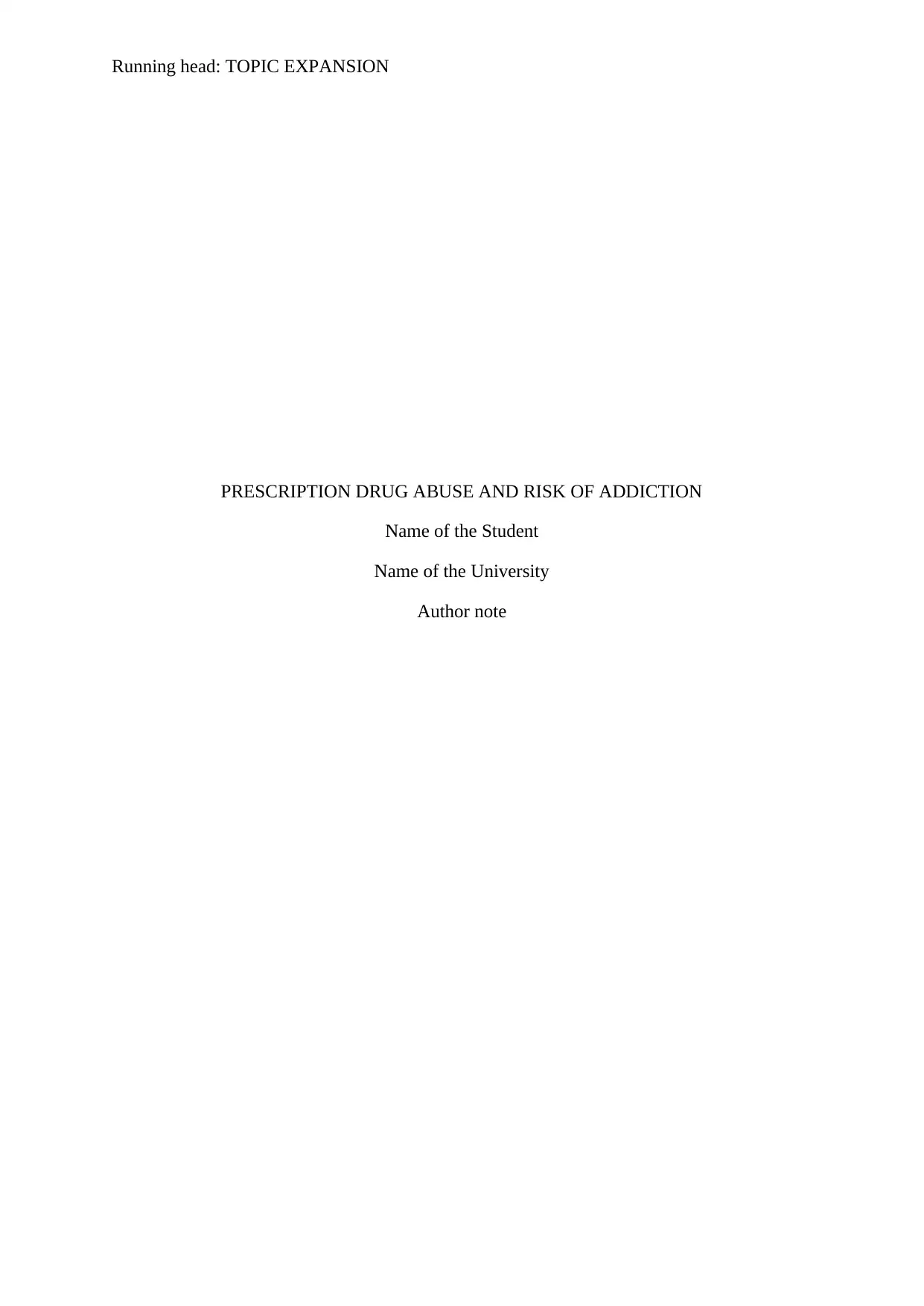
Running head: TOPIC EXPANSION
PRESCRIPTION DRUG ABUSE AND RISK OF ADDICTION
Name of the Student
Name of the University
Author note
PRESCRIPTION DRUG ABUSE AND RISK OF ADDICTION
Name of the Student
Name of the University
Author note
Paraphrase This Document
Need a fresh take? Get an instant paraphrase of this document with our AI Paraphraser
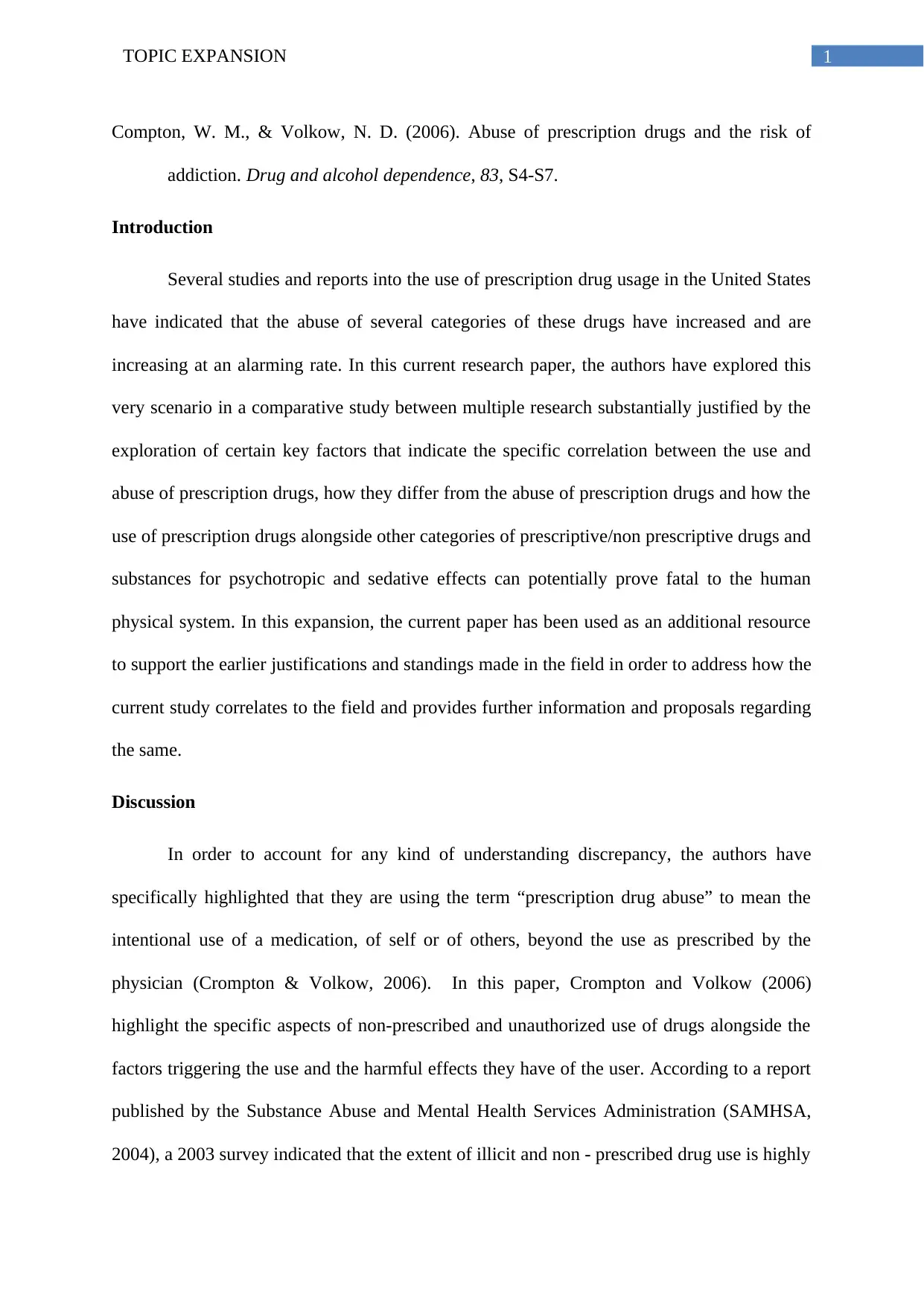
1TOPIC EXPANSION
Compton, W. M., & Volkow, N. D. (2006). Abuse of prescription drugs and the risk of
addiction. Drug and alcohol dependence, 83, S4-S7.
Introduction
Several studies and reports into the use of prescription drug usage in the United States
have indicated that the abuse of several categories of these drugs have increased and are
increasing at an alarming rate. In this current research paper, the authors have explored this
very scenario in a comparative study between multiple research substantially justified by the
exploration of certain key factors that indicate the specific correlation between the use and
abuse of prescription drugs, how they differ from the abuse of prescription drugs and how the
use of prescription drugs alongside other categories of prescriptive/non prescriptive drugs and
substances for psychotropic and sedative effects can potentially prove fatal to the human
physical system. In this expansion, the current paper has been used as an additional resource
to support the earlier justifications and standings made in the field in order to address how the
current study correlates to the field and provides further information and proposals regarding
the same.
Discussion
In order to account for any kind of understanding discrepancy, the authors have
specifically highlighted that they are using the term “prescription drug abuse” to mean the
intentional use of a medication, of self or of others, beyond the use as prescribed by the
physician (Crompton & Volkow, 2006). In this paper, Crompton and Volkow (2006)
highlight the specific aspects of non-prescribed and unauthorized use of drugs alongside the
factors triggering the use and the harmful effects they have of the user. According to a report
published by the Substance Abuse and Mental Health Services Administration (SAMHSA,
2004), a 2003 survey indicated that the extent of illicit and non - prescribed drug use is highly
Compton, W. M., & Volkow, N. D. (2006). Abuse of prescription drugs and the risk of
addiction. Drug and alcohol dependence, 83, S4-S7.
Introduction
Several studies and reports into the use of prescription drug usage in the United States
have indicated that the abuse of several categories of these drugs have increased and are
increasing at an alarming rate. In this current research paper, the authors have explored this
very scenario in a comparative study between multiple research substantially justified by the
exploration of certain key factors that indicate the specific correlation between the use and
abuse of prescription drugs, how they differ from the abuse of prescription drugs and how the
use of prescription drugs alongside other categories of prescriptive/non prescriptive drugs and
substances for psychotropic and sedative effects can potentially prove fatal to the human
physical system. In this expansion, the current paper has been used as an additional resource
to support the earlier justifications and standings made in the field in order to address how the
current study correlates to the field and provides further information and proposals regarding
the same.
Discussion
In order to account for any kind of understanding discrepancy, the authors have
specifically highlighted that they are using the term “prescription drug abuse” to mean the
intentional use of a medication, of self or of others, beyond the use as prescribed by the
physician (Crompton & Volkow, 2006). In this paper, Crompton and Volkow (2006)
highlight the specific aspects of non-prescribed and unauthorized use of drugs alongside the
factors triggering the use and the harmful effects they have of the user. According to a report
published by the Substance Abuse and Mental Health Services Administration (SAMHSA,
2004), a 2003 survey indicated that the extent of illicit and non - prescribed drug use is highly
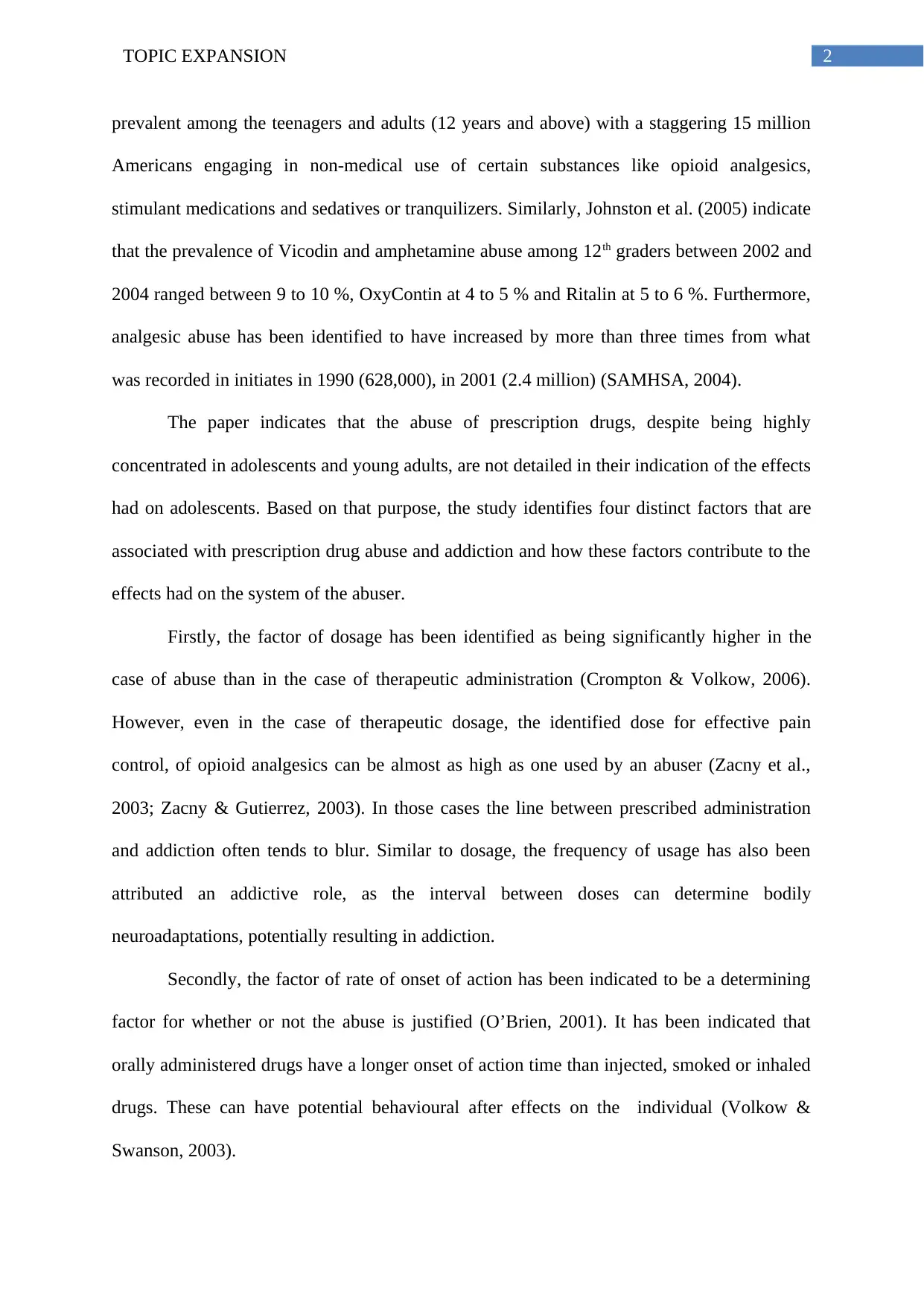
2TOPIC EXPANSION
prevalent among the teenagers and adults (12 years and above) with a staggering 15 million
Americans engaging in non-medical use of certain substances like opioid analgesics,
stimulant medications and sedatives or tranquilizers. Similarly, Johnston et al. (2005) indicate
that the prevalence of Vicodin and amphetamine abuse among 12th graders between 2002 and
2004 ranged between 9 to 10 %, OxyContin at 4 to 5 % and Ritalin at 5 to 6 %. Furthermore,
analgesic abuse has been identified to have increased by more than three times from what
was recorded in initiates in 1990 (628,000), in 2001 (2.4 million) (SAMHSA, 2004).
The paper indicates that the abuse of prescription drugs, despite being highly
concentrated in adolescents and young adults, are not detailed in their indication of the effects
had on adolescents. Based on that purpose, the study identifies four distinct factors that are
associated with prescription drug abuse and addiction and how these factors contribute to the
effects had on the system of the abuser.
Firstly, the factor of dosage has been identified as being significantly higher in the
case of abuse than in the case of therapeutic administration (Crompton & Volkow, 2006).
However, even in the case of therapeutic dosage, the identified dose for effective pain
control, of opioid analgesics can be almost as high as one used by an abuser (Zacny et al.,
2003; Zacny & Gutierrez, 2003). In those cases the line between prescribed administration
and addiction often tends to blur. Similar to dosage, the frequency of usage has also been
attributed an addictive role, as the interval between doses can determine bodily
neuroadaptations, potentially resulting in addiction.
Secondly, the factor of rate of onset of action has been indicated to be a determining
factor for whether or not the abuse is justified (O’Brien, 2001). It has been indicated that
orally administered drugs have a longer onset of action time than injected, smoked or inhaled
drugs. These can have potential behavioural after effects on the individual (Volkow &
Swanson, 2003).
prevalent among the teenagers and adults (12 years and above) with a staggering 15 million
Americans engaging in non-medical use of certain substances like opioid analgesics,
stimulant medications and sedatives or tranquilizers. Similarly, Johnston et al. (2005) indicate
that the prevalence of Vicodin and amphetamine abuse among 12th graders between 2002 and
2004 ranged between 9 to 10 %, OxyContin at 4 to 5 % and Ritalin at 5 to 6 %. Furthermore,
analgesic abuse has been identified to have increased by more than three times from what
was recorded in initiates in 1990 (628,000), in 2001 (2.4 million) (SAMHSA, 2004).
The paper indicates that the abuse of prescription drugs, despite being highly
concentrated in adolescents and young adults, are not detailed in their indication of the effects
had on adolescents. Based on that purpose, the study identifies four distinct factors that are
associated with prescription drug abuse and addiction and how these factors contribute to the
effects had on the system of the abuser.
Firstly, the factor of dosage has been identified as being significantly higher in the
case of abuse than in the case of therapeutic administration (Crompton & Volkow, 2006).
However, even in the case of therapeutic dosage, the identified dose for effective pain
control, of opioid analgesics can be almost as high as one used by an abuser (Zacny et al.,
2003; Zacny & Gutierrez, 2003). In those cases the line between prescribed administration
and addiction often tends to blur. Similar to dosage, the frequency of usage has also been
attributed an addictive role, as the interval between doses can determine bodily
neuroadaptations, potentially resulting in addiction.
Secondly, the factor of rate of onset of action has been indicated to be a determining
factor for whether or not the abuse is justified (O’Brien, 2001). It has been indicated that
orally administered drugs have a longer onset of action time than injected, smoked or inhaled
drugs. These can have potential behavioural after effects on the individual (Volkow &
Swanson, 2003).
⊘ This is a preview!⊘
Do you want full access?
Subscribe today to unlock all pages.

Trusted by 1+ million students worldwide
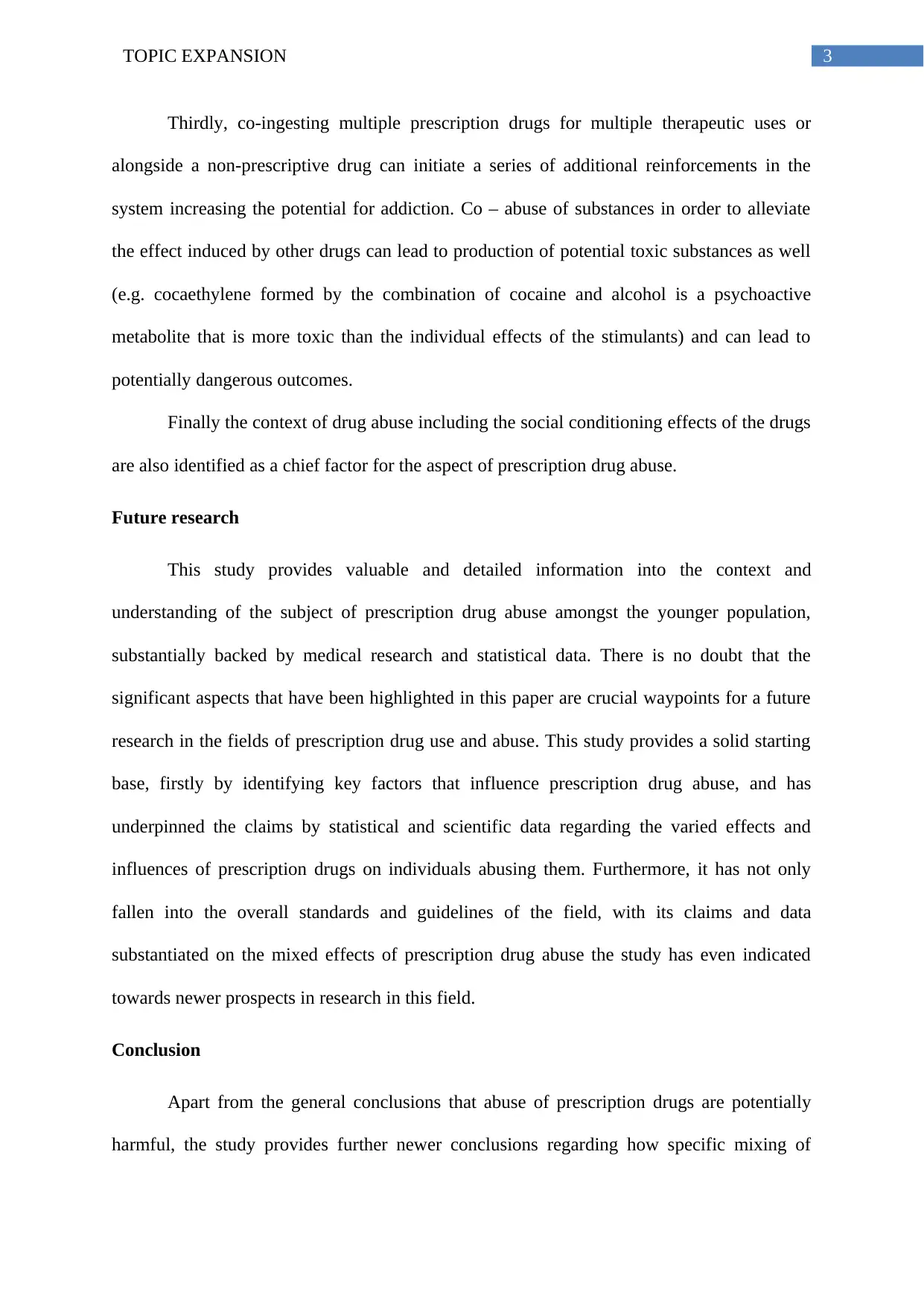
3TOPIC EXPANSION
Thirdly, co-ingesting multiple prescription drugs for multiple therapeutic uses or
alongside a non-prescriptive drug can initiate a series of additional reinforcements in the
system increasing the potential for addiction. Co – abuse of substances in order to alleviate
the effect induced by other drugs can lead to production of potential toxic substances as well
(e.g. cocaethylene formed by the combination of cocaine and alcohol is a psychoactive
metabolite that is more toxic than the individual effects of the stimulants) and can lead to
potentially dangerous outcomes.
Finally the context of drug abuse including the social conditioning effects of the drugs
are also identified as a chief factor for the aspect of prescription drug abuse.
Future research
This study provides valuable and detailed information into the context and
understanding of the subject of prescription drug abuse amongst the younger population,
substantially backed by medical research and statistical data. There is no doubt that the
significant aspects that have been highlighted in this paper are crucial waypoints for a future
research in the fields of prescription drug use and abuse. This study provides a solid starting
base, firstly by identifying key factors that influence prescription drug abuse, and has
underpinned the claims by statistical and scientific data regarding the varied effects and
influences of prescription drugs on individuals abusing them. Furthermore, it has not only
fallen into the overall standards and guidelines of the field, with its claims and data
substantiated on the mixed effects of prescription drug abuse the study has even indicated
towards newer prospects in research in this field.
Conclusion
Apart from the general conclusions that abuse of prescription drugs are potentially
harmful, the study provides further newer conclusions regarding how specific mixing of
Thirdly, co-ingesting multiple prescription drugs for multiple therapeutic uses or
alongside a non-prescriptive drug can initiate a series of additional reinforcements in the
system increasing the potential for addiction. Co – abuse of substances in order to alleviate
the effect induced by other drugs can lead to production of potential toxic substances as well
(e.g. cocaethylene formed by the combination of cocaine and alcohol is a psychoactive
metabolite that is more toxic than the individual effects of the stimulants) and can lead to
potentially dangerous outcomes.
Finally the context of drug abuse including the social conditioning effects of the drugs
are also identified as a chief factor for the aspect of prescription drug abuse.
Future research
This study provides valuable and detailed information into the context and
understanding of the subject of prescription drug abuse amongst the younger population,
substantially backed by medical research and statistical data. There is no doubt that the
significant aspects that have been highlighted in this paper are crucial waypoints for a future
research in the fields of prescription drug use and abuse. This study provides a solid starting
base, firstly by identifying key factors that influence prescription drug abuse, and has
underpinned the claims by statistical and scientific data regarding the varied effects and
influences of prescription drugs on individuals abusing them. Furthermore, it has not only
fallen into the overall standards and guidelines of the field, with its claims and data
substantiated on the mixed effects of prescription drug abuse the study has even indicated
towards newer prospects in research in this field.
Conclusion
Apart from the general conclusions that abuse of prescription drugs are potentially
harmful, the study provides further newer conclusions regarding how specific mixing of
Paraphrase This Document
Need a fresh take? Get an instant paraphrase of this document with our AI Paraphraser
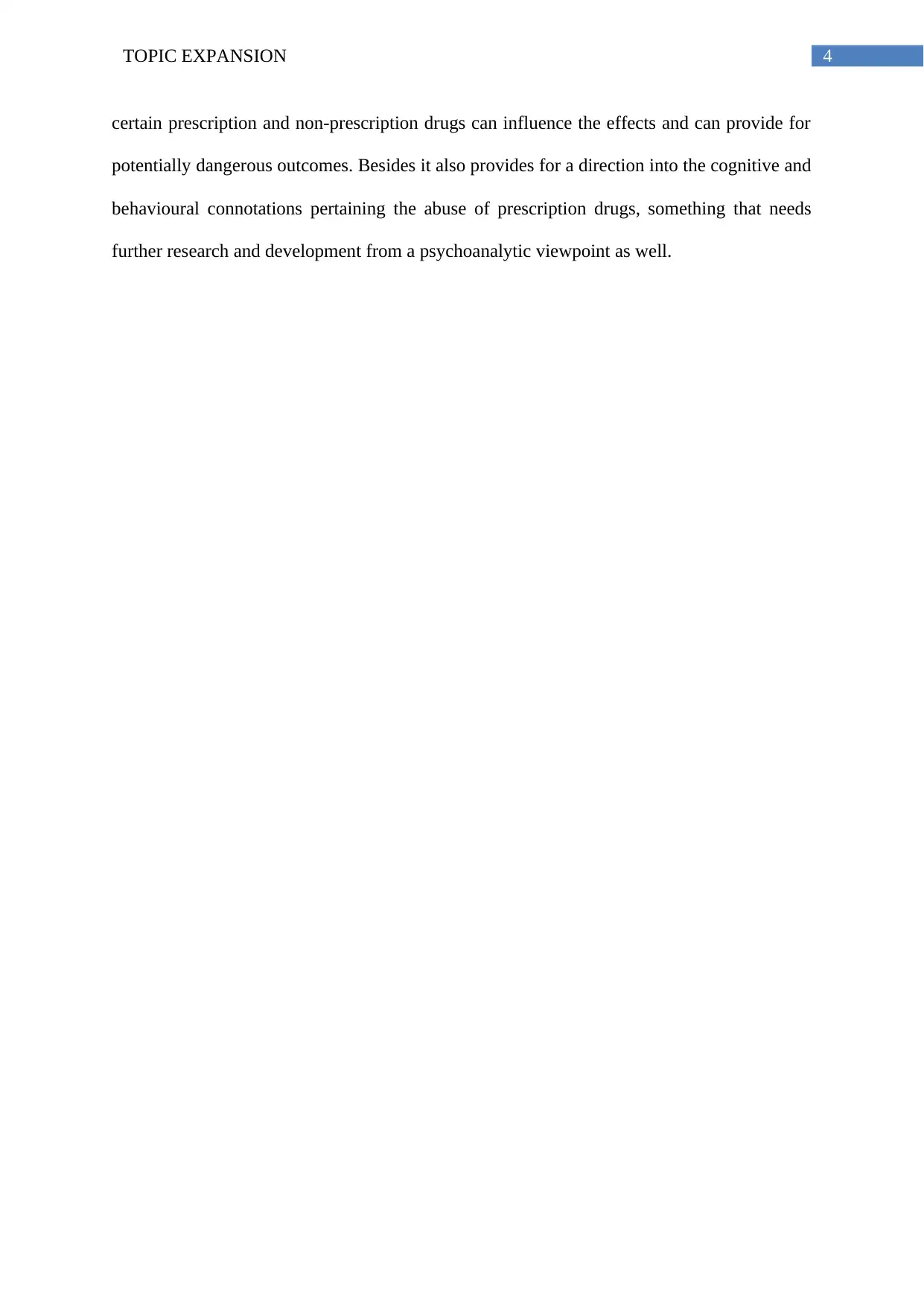
4TOPIC EXPANSION
certain prescription and non-prescription drugs can influence the effects and can provide for
potentially dangerous outcomes. Besides it also provides for a direction into the cognitive and
behavioural connotations pertaining the abuse of prescription drugs, something that needs
further research and development from a psychoanalytic viewpoint as well.
certain prescription and non-prescription drugs can influence the effects and can provide for
potentially dangerous outcomes. Besides it also provides for a direction into the cognitive and
behavioural connotations pertaining the abuse of prescription drugs, something that needs
further research and development from a psychoanalytic viewpoint as well.
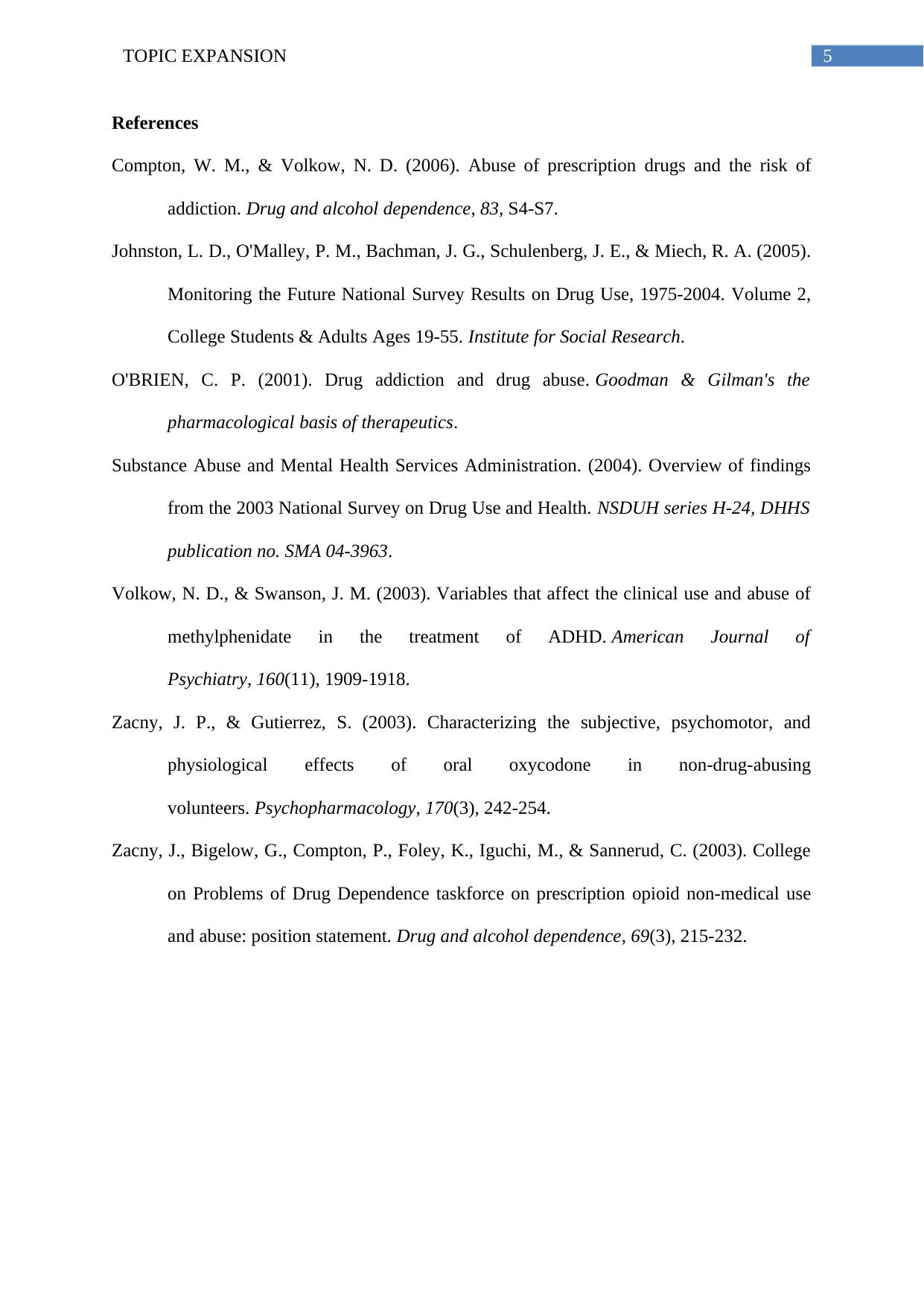
5TOPIC EXPANSION
References
Compton, W. M., & Volkow, N. D. (2006). Abuse of prescription drugs and the risk of
addiction. Drug and alcohol dependence, 83, S4-S7.
Johnston, L. D., O'Malley, P. M., Bachman, J. G., Schulenberg, J. E., & Miech, R. A. (2005).
Monitoring the Future National Survey Results on Drug Use, 1975-2004. Volume 2,
College Students & Adults Ages 19-55. Institute for Social Research.
O'BRIEN, C. P. (2001). Drug addiction and drug abuse. Goodman & Gilman's the
pharmacological basis of therapeutics.
Substance Abuse and Mental Health Services Administration. (2004). Overview of findings
from the 2003 National Survey on Drug Use and Health. NSDUH series H-24, DHHS
publication no. SMA 04-3963.
Volkow, N. D., & Swanson, J. M. (2003). Variables that affect the clinical use and abuse of
methylphenidate in the treatment of ADHD. American Journal of
Psychiatry, 160(11), 1909-1918.
Zacny, J. P., & Gutierrez, S. (2003). Characterizing the subjective, psychomotor, and
physiological effects of oral oxycodone in non-drug-abusing
volunteers. Psychopharmacology, 170(3), 242-254.
Zacny, J., Bigelow, G., Compton, P., Foley, K., Iguchi, M., & Sannerud, C. (2003). College
on Problems of Drug Dependence taskforce on prescription opioid non-medical use
and abuse: position statement. Drug and alcohol dependence, 69(3), 215-232.
References
Compton, W. M., & Volkow, N. D. (2006). Abuse of prescription drugs and the risk of
addiction. Drug and alcohol dependence, 83, S4-S7.
Johnston, L. D., O'Malley, P. M., Bachman, J. G., Schulenberg, J. E., & Miech, R. A. (2005).
Monitoring the Future National Survey Results on Drug Use, 1975-2004. Volume 2,
College Students & Adults Ages 19-55. Institute for Social Research.
O'BRIEN, C. P. (2001). Drug addiction and drug abuse. Goodman & Gilman's the
pharmacological basis of therapeutics.
Substance Abuse and Mental Health Services Administration. (2004). Overview of findings
from the 2003 National Survey on Drug Use and Health. NSDUH series H-24, DHHS
publication no. SMA 04-3963.
Volkow, N. D., & Swanson, J. M. (2003). Variables that affect the clinical use and abuse of
methylphenidate in the treatment of ADHD. American Journal of
Psychiatry, 160(11), 1909-1918.
Zacny, J. P., & Gutierrez, S. (2003). Characterizing the subjective, psychomotor, and
physiological effects of oral oxycodone in non-drug-abusing
volunteers. Psychopharmacology, 170(3), 242-254.
Zacny, J., Bigelow, G., Compton, P., Foley, K., Iguchi, M., & Sannerud, C. (2003). College
on Problems of Drug Dependence taskforce on prescription opioid non-medical use
and abuse: position statement. Drug and alcohol dependence, 69(3), 215-232.
⊘ This is a preview!⊘
Do you want full access?
Subscribe today to unlock all pages.

Trusted by 1+ million students worldwide
1 out of 6
Related Documents
Your All-in-One AI-Powered Toolkit for Academic Success.
+13062052269
info@desklib.com
Available 24*7 on WhatsApp / Email
![[object Object]](/_next/static/media/star-bottom.7253800d.svg)
Unlock your academic potential
Copyright © 2020–2025 A2Z Services. All Rights Reserved. Developed and managed by ZUCOL.



